Fujifilm Finepix X100 Review
Fujifilm Finepix X100
At nearly £1,000, this compact camera is one of the most exclusive going. Can it possibly be worth the outlay?
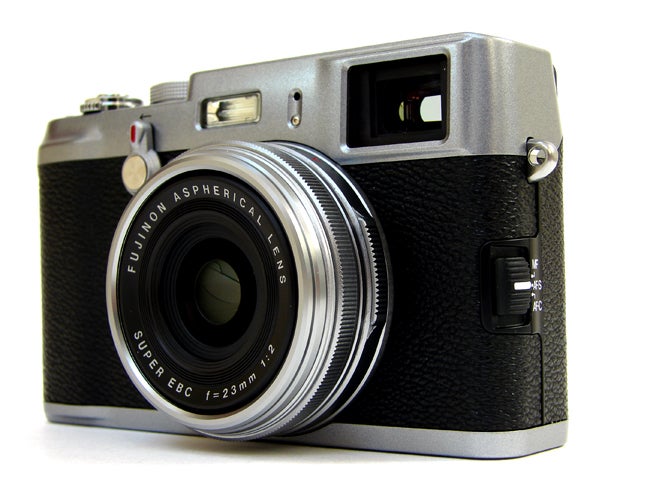
Verdict
Pros
- Superb quality quality
- Exceptional image quality
- Versatile yet easy to use
Cons
- Very expensive
- Fixed zoom lens
- Slightly fiddly controls
Key Specifications
- Review Price: £899.99
- 12.3 megapixel APS-C sensor
- 50mm fixed lens (f2.0)
- All metal body
- Physical dials for exposure settings
Did anyone mention an age of austerity? Certainly not at Fuji Towers, from whence has appeared the manufacturer’s most expensive and inevitably most exciting digital camera for coming up to a decade. Announced at Photokina six months ago but just hitting the shelves now for a price of £999.99, the 12.3 effective megapixel FinePix Finepix X100 has got the photographic industry seriously a-buzz. 
The basics of the new high-end model are this: it’s a ”compact” camera boasting a large APS-C sized CMOS sensor (of the sort normally only found in SLRs), a fixed 35mm equivalent lens with bright f/2.0 maximum aperture, and a gorgeously classic construction. The combination of which should result in superb quality photos, with low light performance being particularly exceptional. Something that is only highlighted by the presence of a maximum ISO12800, the kind of spec found on a semi pro DSLR.
The target audience here is the monied digital SLR user looking for a more portable back up. And one who presumably isn’t sufficiently tempted by a compact system camera such as the Sony NEX series, Olympus Pens, Panasonic Lumix G, Samsung NX or even the Ricoh GXR as an alternative. All retail for less money, and all, unlike the Fuji, allow the optic on the front to be swapped. Other yet more portable premium compact contenders include the Canon PowerShot G12, Nikon CoolPix P7000, Samsung EX1, Panasonic Lumix DMC-LX5 and Olympus XZ-1. Again they’re all impressive and again considerably cheaper. 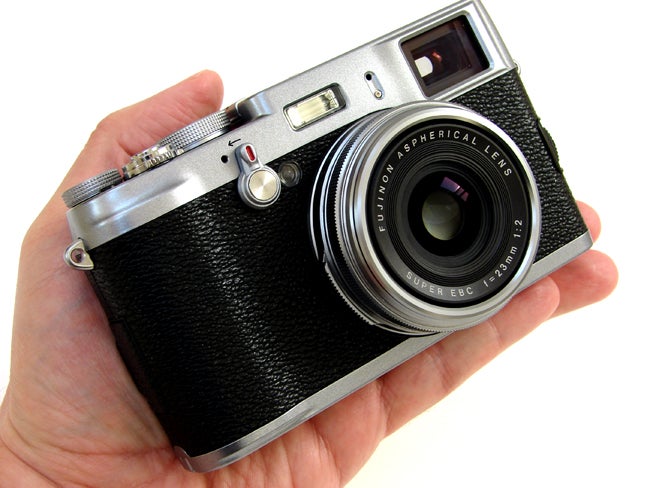
The camera the Fuji most reminds us of most though in terms of tongue-lolling luxuriousness is the Leica X1. Like the X100, that too features an APS-C sized sensor just like a DSLR proper, plus a 36mm equivalent lens (in 35mm film terms) to the Fuji’s 35mm. At the time of writing the Leica X1 was retailing for £1395, having held its value since its release over a year ago; making the X100 actually good value in comparison. Whereas that model sports a bright f/2.8 aperture though, the Fuji offers up an even brighter maximum f/2.0. Set against that is the fact the Leica branding has a perceived worth of its own, with the emphasis being on perceived.
Inevitably you get Raw capture as well as JPEG, however video isn’t so well catered for with just 1280×720 pixel clips at 24 frames per second on offer. Standard focus distance is 80cm to infinity, or 10cm to two metres in macro close up mode. 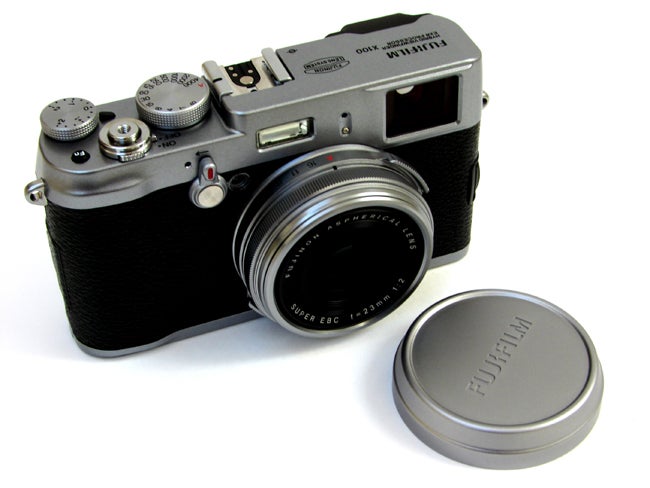
As we’re ‘stuck’ with the one lens, the X100 has to satisfy as an all rounder as is, which regardless of your photographic merits is always going to be something of a struggle. It’s therefore a camera on which your images benefit from a more considered, reflective approach to subject matter. With its maker describing the X100 as delivering the best image quality in its long and illustrious history, has this move towards enticing the well-heeled photo enthusiast rather than typical Argos shopper paid off? Read on to find out…
With the top and bottom plates fashioned from die cast magnesium alloy the Fujifilm X100 feels both reassuringly solid and comfortingly retro at the same time, despite the state-of-the-art technology making up its innards. As when we first encountered Olympus’ Digital Pen series a couple of years back with the advent of the similarly ‘classic’ looking E-P1, the X100 feels like the kind of camera we imagined simply wouldn’t be made any more. At 405g in weight without battery or card, it’s still lighter than a beginner’s DSLR too, though is not exactly what you’d call pocketable, which some will straight away argue defeats its purpose.
With rangefinder camera-style dials on the top to twist and turn the X100 feels very much like a camera creative photographers can fully engage with too. Sadi dials consist of aperture and manual focus rings at the front, plus a viewfinder lever to flick back and forth. Ironically, though, all these dials squashed into such a small space does make them rather fiddly – something that’s especially weird as there appears to be ample space round the camera to expand into. 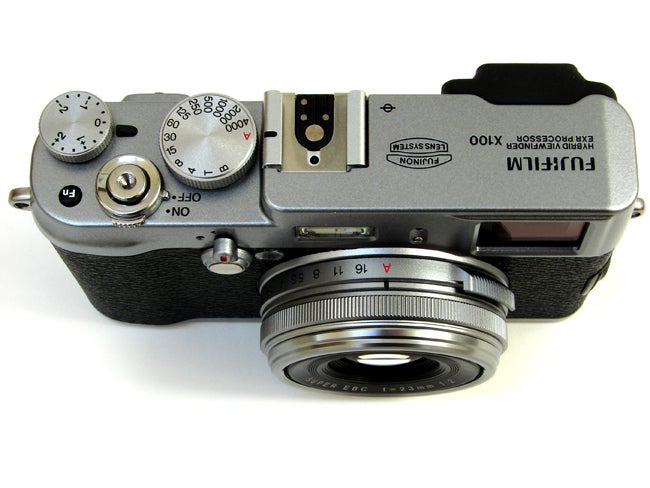
The control layout and feature set here is almost identical to that of the Leica X1, except here Fuji’s flash is fixed into the chassis, just above the lens, rather than in a pop-up compartment in the top plate – the latter is admittedly a much better arrangement. Slightly off centre we get a vacant hotshoe for adding accessory flash too, and adjacent to this the largest dial here, for controlling shutter speed, with the choice ranging from 30 seconds to 1/4000 sec. We also get a smaller exposure compensation dial, the options being /- 2EV, and in between the two dials sits a springy shutter release button, encircled by the power switch. The ridged front edge of the latter provides a purchase point for the forefinger, making it look like the zoom lever typically found on a pocket compact. Except here of course there is no zoom.
Easily overlooked next to this is a teeny ‘Fn’ (function) button to which favourite settings can be attributed, thus avoiding the need to otherwise drill down into the main camera menus (not that this is such a hardship) to find favoured functions, such as ISO for example.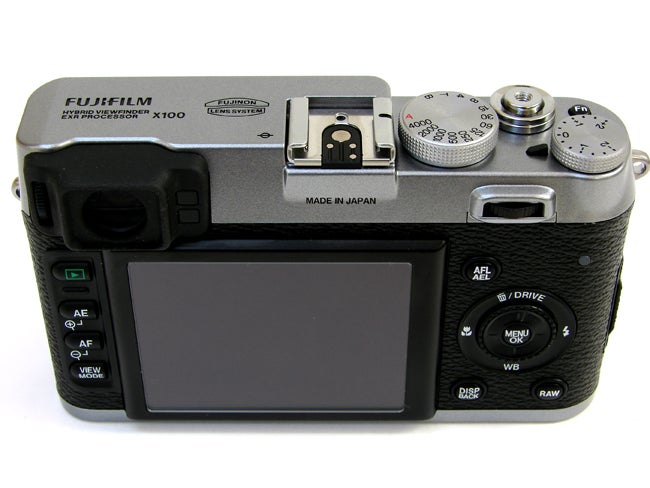
Aperture can be adjusted on the fly via a stepped ring encircling the lens, or you can simply leave it on the ‘A’ setting to enable the camera’s Program AE mode to kick in. Sitting just in front of this is a manual focus ring, with the ability to flick between manual focus, continuous auto focus and single shot AF via a DSLR-like mode switch located unobtrusively at the camera’s side rather than immediately below or adjacent to the lens itself.
As this is an enthusiast model conceivably aimed at users who stuck one of Fuji’s Provia, Velvia or Astia films in their cameras at some stage in the past, the X100 sensibly includes modes apeing the look of each tucked within the menu options; a staple of Fuji’s mid-range compacts for quite a while – and why not as they provide an added USP to help set the camera apart from the herd.
But most notable here is the fact that, in a world first as far as we’re aware, Fuji has squeezed both an optical viewfinder and electronic viewfinder (EVF) into the same large, bright window – which Fuji naturally refers to as a ‘hybrid’ viewfinder – though because of the positioning the left edge of the lens barrel does peep into view. This right of frame distraction doesn’t appear if alternatively using the adequate but not huge 2.8-inch, 460k dot resolution LCD screen as a viewfinder, so that’s what in practice we found ourselves referring to just as much. The X100 could be said to offer a best of both world’s solution.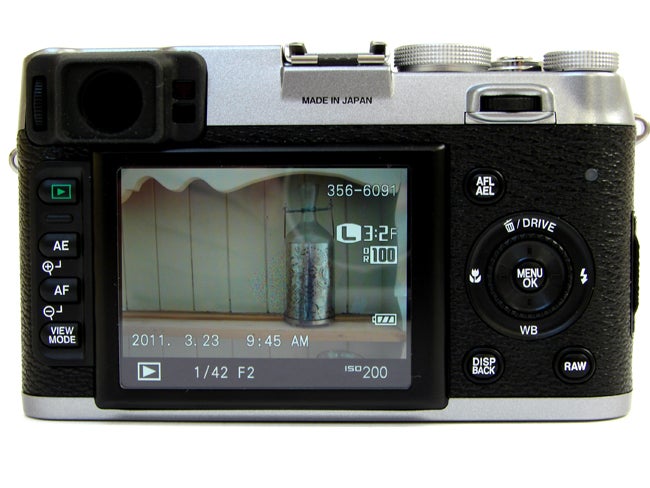
Switching between optical viewfinder with overlaid electronic display and incredibly high 1,400,000 dot resolution EVF is, meanwhile, simply a matter of flicking the lever at the front. This might have been more logically placed at the back, but at least its location ensures it’s not accidentally flicked when gripping the camera in both hands for a steadier shot. Another neat feature is the fact that the backplate screen switches off as you bring an eye level to the viewfinder/s, thanks to a built-in eye sensor alongside. Incidentally the monitor’s thick screen surround makes it appear as if you might be able to tuck a fingernail beneath it and flip it out but you can’t. Not a big issue but a minor consideration for a next generation model perhaps?
The camera powers up from cold in a couple of seconds, meaning a fractional delay as you immediately move your forefinger from power switch to shutter release buton, but this is not too shabby by any means. Moreover, in not having a zoom that allows framing to be altered in seconds, the X100 promotes a more considered approach anyway, which is rarely a bad thing. That said the autofocus does take just that fraction longer than we might hope for if you’re trying to capture moving object such as pets.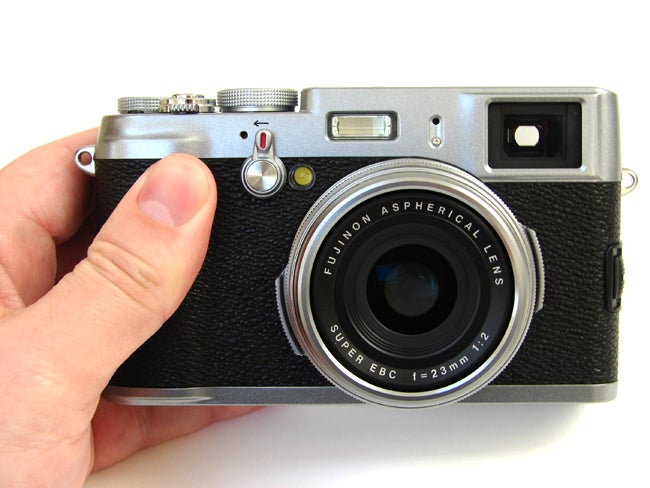
Take a shot, and a Fine quality, full resolution JPEG is committed to memory, here SD, SDHC or SDXC card, in around two seconds. A Raw file is only a fractionally longer wait (under three seconds), and there is the opportunity to shoot Raw in conjunction with both a Fine compression level JPEG, and a highly more compressed ‘Normal’ level JPEG.
We were lucky enough to be testing the X100 under some early spring sunshine, giving rise to blue skies and verdant flora, conditions that were bound to show most cameras in (literally) the very best light. Incidentally, this was also perfect weather to test the X100’s built-in neutral density (ND) filter. Surely the Fuji couldn’t fail to impress?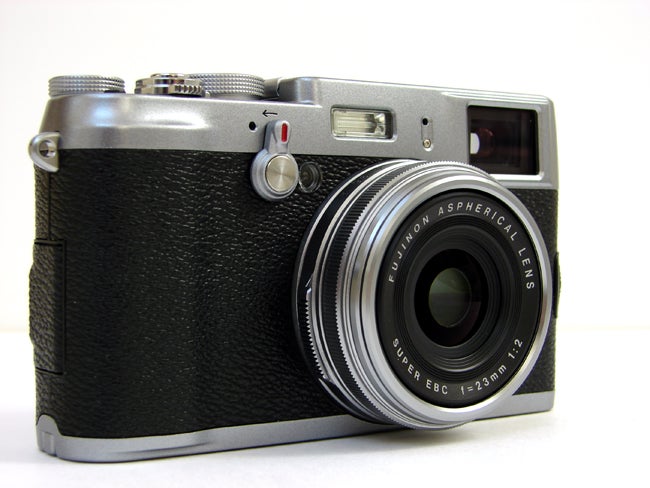
Well yes, and no. Unfortunately such ‘ideal’ conditions very occasionally gave rise to familiar bugbears such as visible pixel fringing – most notably on dark tress branches part silhouetted against a bright sky – as well as burnt out highlights, but as these are common issues with the vast majority of digital cameras neither are deal breakers. It is in low(er) light then where, as expected, the X100 really shines. As our ISO samples show, it’s only really at top whack ISO12800 equivalent setting that we’re seeing visible degradation of sharpness across the entirety of the image as detail is smoothed in the limitation of image noise, but even then the performance isn’t bad at all. We’d be quite happy shooting at up to ISO6400 on a regular basis, and were hard pressed to find sign of any noise at ISO1600 and below. Impressive stuff.
In terms of which colour setting to go for on a regular basis, we found Velvia was the setting that seemed to best match what we were seeing with our own eyes at the time. Comes down to personal preference of course, but in our humble opinion the default Provia setting produced colours that were a tad drab and certainly less well saturated than nature intended, while Astia we felt was not only soft in appearance but also made images appear a little dated in style.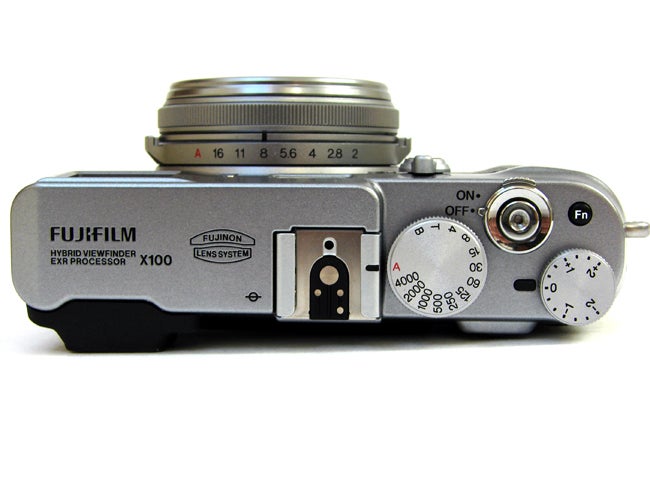
While for us the X100’s pictures don’t quite match the almost 3D richness of shots we’ve taken with the Leica X1, at their best we were hard pressed to distinguish them from those of a mid range DSLR, which, with a decent lens will admittedly set you back just as much as is being asked here. So as a more portable back up to an existing DSLR, provided you don’t need greater lens versatility than what is being offered, the X100 indeed fills the role that Fuji intended it to.
We’ve just skated on the surface of the X100’s possibilities here, but the bottom line is that if you are after a high-quality photo producing tool that will set your creative juices flowing then the X100 is a great choice. It particularly excels in low light and where you want the background thrown out of focus to concentrate the viewer’s gaze. Plus, like those Leicas of yesteryear, the rock solid build quality should allow you to keep shooting for years.
”’Verdict”’
The Fujifilm X100 certainly isn’t for everyone with its fixed lens, sizeable body and even more sizeable price tag. However, its rock-solid build quality, superb image quality – with exceptional low light performance – and more compact stance than an equivalent DSLR means it will have pride of place for many enthusiasts and pros as a back up to their main kit. However, if in the unlikely event that you’re considering this camera without already owning a DSLR, then we’d have to concede that any one of many low- to mid-range DSLRs, such as the Nikon D3100 or Canon EOS 550D, would be a more sensible bet. The Leica X1 offers an almost directly comparable alternative but at several hundred pounds more, the X100 is the clear choice of those two.
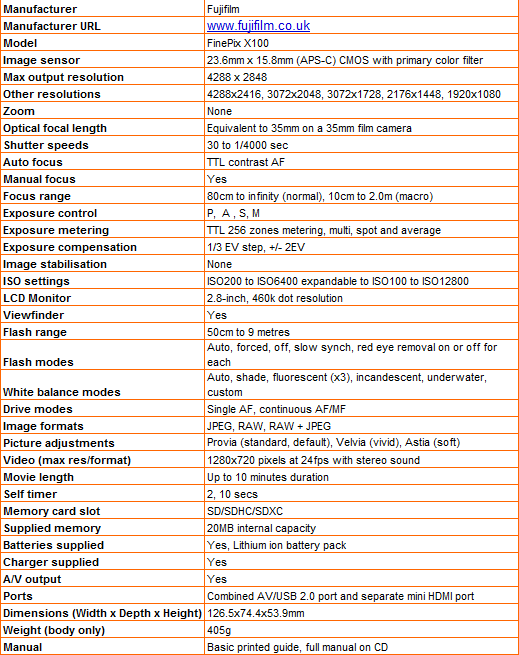
The following ISO examples were taken with the aid of a tripod and available daylight and run the gamut of the Fuji X100’s extensive manually adjustable range, expandable at both ends of the scale to ISO100 (from ISO200) and ISO12800 (from ISO6400) respectively to give no fewer than 18 incremental settings. We utilised the default ‘Provia’ picture mode and auto white balance throughout, and rather than show every single option, we’ve picked some select highlights.
—-
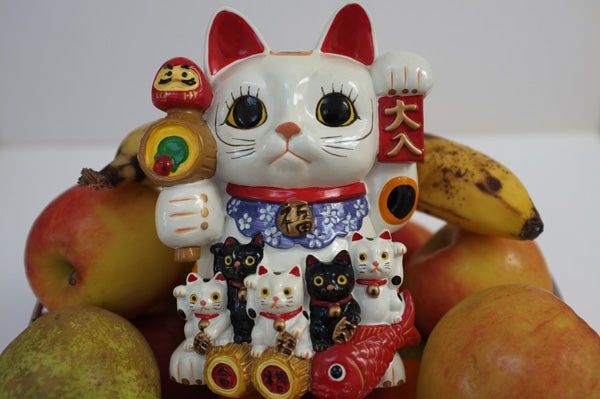
—-
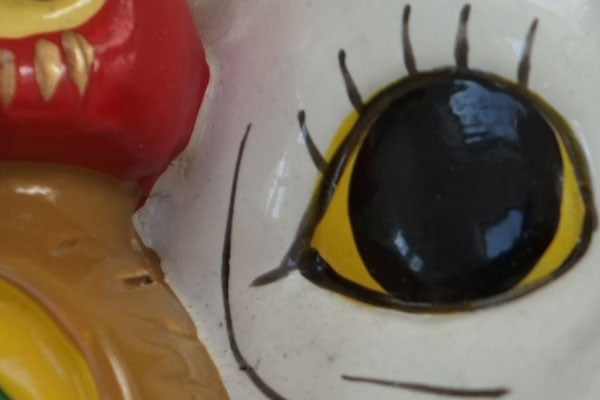
We’re at the lowest selectable setting of ISO100 equivalent and not only is, as expected, there no noise to be found in shadow areas, but rather the lens’ shallow depth of field here has highlighted detail so crisp you can almost reach out and touch the objects in our test picture.
—-
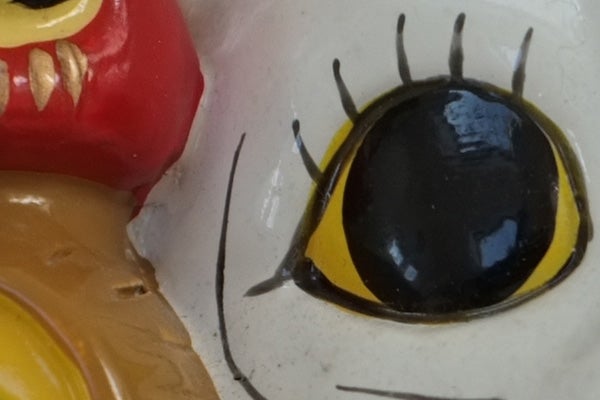
Same set up at ISO200 and little difference to report.
—-
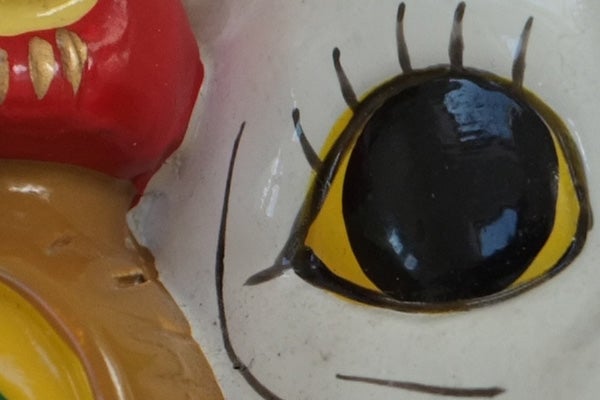
We’re at ISO400 and again no noise is visible even if closely cropping in to shadow areas.
—-
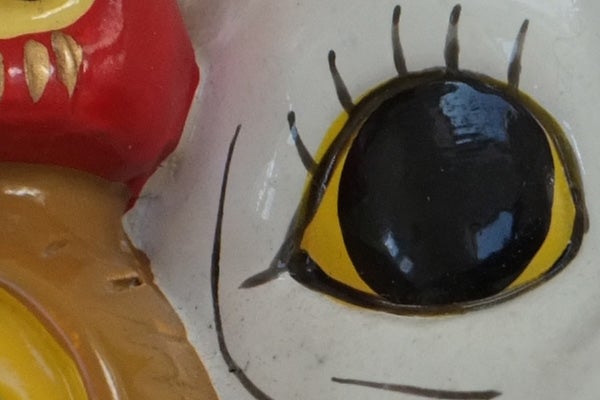
We’re at ISO800 and the only criticism we can level is a slight softening of edge detail on close inspection, but it’s so slight that we may be imagining it.
—-
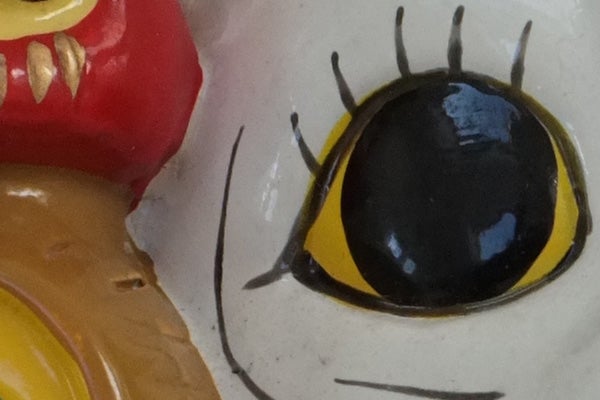
Again any difference at ISO1600 is barely noticeable and overall this is comparable to the performance compact rivals manage at ISO400; very impressive indeed.
—-
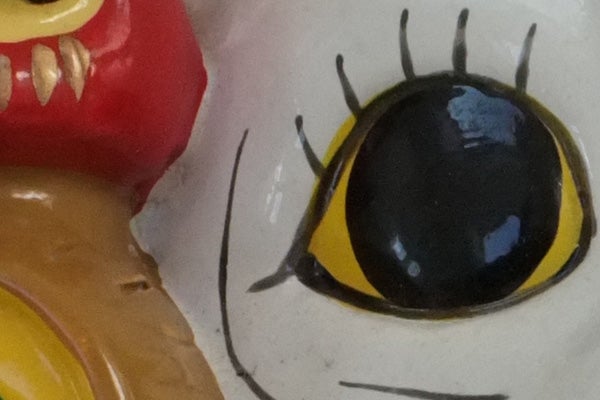
Fractionally softer at ISO3200. Although again we’re hard pressed to notice a marked difference between this and the earlier settings.
—-
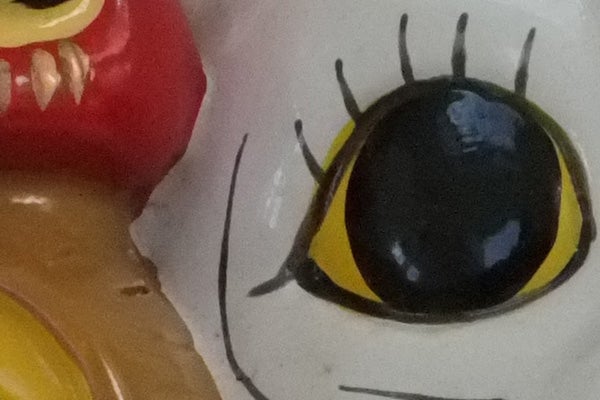
Detail is looking a little smoother at ISO6400 and, if we squint really hard, we’re beginning to see the first visible appearance of noise. But it really isn’t anything to worry about at all.
—-
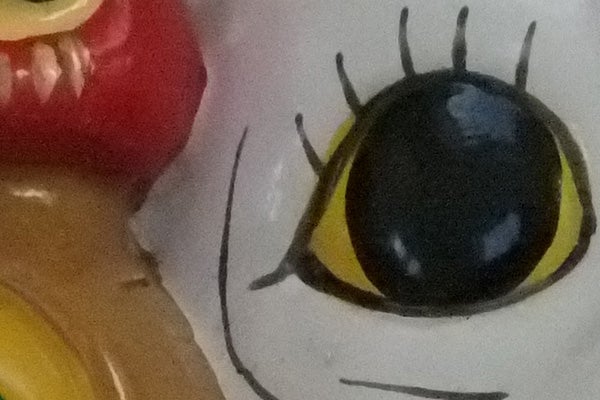
Pushing the envelope at ISO12800 equivalent and we’re seeing softening across the entire image on close inspection to limit noise, Again, this is as good a result as some lesser compacts manage at ISO1600, so it seems that Fuji’s bright lens, big sensor combo really lives up to the pre-release hype and delivers the goods for low light photographers.
—-
A more general selection of test shots are revealed on this page and next to act as an evaluation of the Fuji X100 in a variety of shooting conditions.
—-

Great colours courtesy of the Velvia picture mode in this wideangle shot. Here, interestingly, the tones are nearer to those in the scene at the time than the rather muted Provia mode (the camera’s default setting) delivered. Good edge to edge detail as well, even if we spot some mild pixel fringing creeping in to the top left corner.
—-
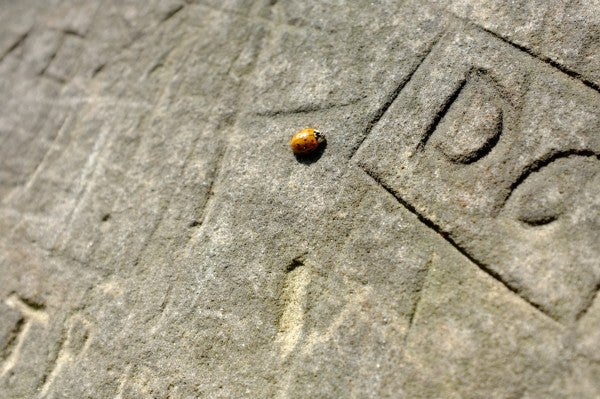
By contrast here’s a close up shot in default 3:2 image aspect ratio, taken in the X100’s macro mode. Detail is such that you can spot grains of dirt/dust on the ladybird’s body, if enlarging the central portion of the shot, as well as the grain of the surrounding stonework. Impressive stuff.
—-

Another closer subject; our standard rusty gate shot. No problem here picking out brownish areas of rust visible beneath flaking paintwork, even if we’ve lost some highlight detail in the insignia atop the gate.
—-
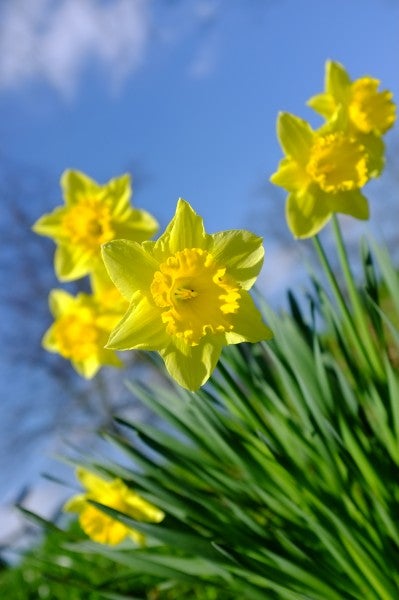
If it’s detail you want through, plus a shallow depth of field to really draw the viewer’s attention to a specific portion of the frame, the X100 is capable of delivering some really lovely examples, such as that shown above.
—-
Here are some general test shots taken with the X100 to give an idea of performance ability when it comes to image quality, dynamic range, colour rendition and focal range.
—-
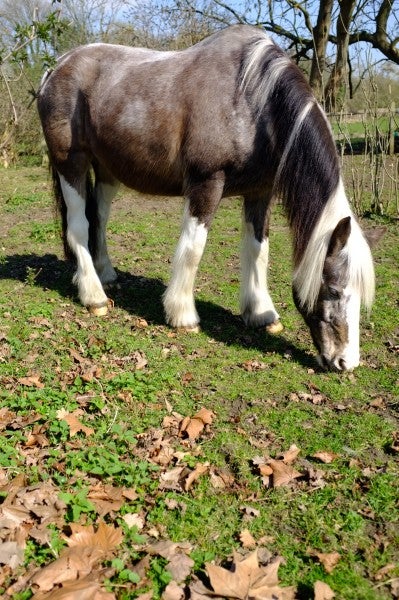
No horsing around here; some lovely natural colours with focus nicely centred on our subject and the edges subtly but attractively blurred.
—-

Another macro shot taken with the Fuji X100 which has reduced the portion of the frame in focus to a very tight central area. Once again colours are attractively natural in tone. We really couldn’t hope for better.
—-
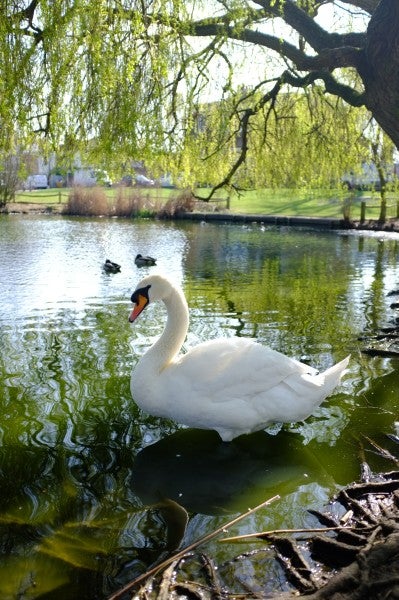
The potential for attractively de-focused backgrounds, one of the X100’s real strengths, and directing the attention onto the swan central to our frame has delivered another charming tableau.
—-

With Velvia mode selected the Fuji X100 has delivered superbly realistic colours and an almost three dimensionalimage, letting the viewer feel as if they could reach out and touch the fronds atop the mossy wall here.
—-
Trusted Score
Score in detail
-
Value 8
-
Image Quality 9
Features
| Camera type | Digital SLR |
| Megapixels (Megapixel) | Megapixel |
| Optical Zoom (Times) | 12 Xx |
| Image Sensor | CMOS |
| Image Stabilisation | Optical |
| LCD Monitor | 3 in, 2.8 in |
| Flash modes | Auto Flash, Flash OFF, Flash ON, Red-eye Reduction, Accessory Shoe, Built-in Flash |
| Video (max res/format) | 640 x 480, 1280 x 720 |

